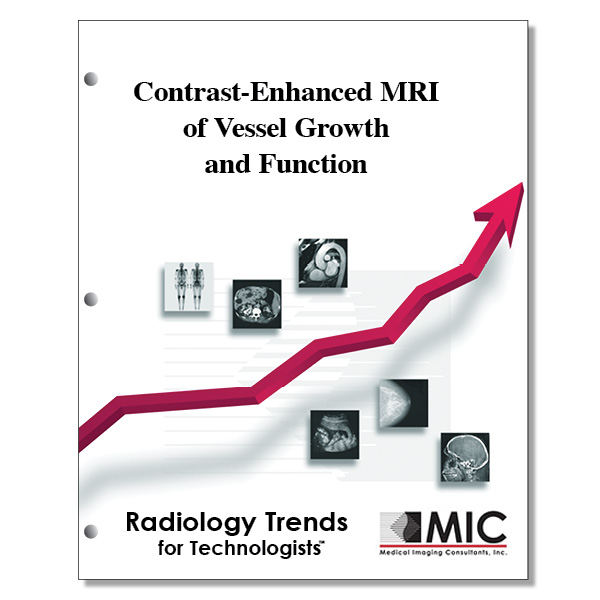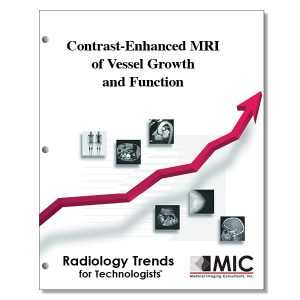

Contrast-Enhanced MRI of Vessel Growth and Function
A look at how MR imaging can depict both established and developing vasculature with techniques involving intravenously administered contrast agents.
Course ID: Q00296 Category: Radiology Trends for Technologists Modality: MRI3.25 |
Satisfaction Guarantee |
$34.00
- Targeted CE
- Outline
- Objectives
Targeted CE per ARRT’s Discipline, Category, and Subcategory classification for enrollments starting after February 8, 2023:
[Note: Discipline-specific Targeted CE credits may be less than the total Category A credits approved for this course.]
Magnetic Resonance Imaging: 3.00
Patient Care: 0.25
Patient Interactions and Management: 0.25
Image Production: 2.00
Sequence Parameters and Options: 0.50
Data Acquisition, Processing, and Storage: 1.50
Procedures: 0.75
Neurological: 0.25
Body: 0.25
Musculoskeletal: 0.25
Registered Radiologist Assistant: 1.25
Patient Care: 0.25
Pharmacology: 0.25
Procedures: 1.00
Neurological, Vascular, and Lymphatic Sections: 1.00
Outline
- Introduction
- Mechanisms of Neovascularization
- Morphologic Imaging
- Contrast-enhanced MR Imaging
- Blood Pool Agents
- Vessel Size Imaging
- Functional Imaging
- Dynamic Contrast-enhanced MR Imaging
- Data Acquisition
- Vascular Input Function
- Model Validation and Model Accuracy
- Applications
- Myocardial Perfusion Imaging
- Molecular Imaging
- Cellular Imaging
- Vasculogenesis
- Clinical Considerations and Future Directions
- Contrast Agent Safety
- High Field Strength
- Conclusions
Objectives
Upon completion of this course, students will:
- understand why MRI is beneficial for imaging the vascular system
- realize why contrast-enhanced MRI has benefits over nonenhanced MRI for imaging the neovasculature
- learn about the process by which new vessels sprout from pre-existing ones
- recognize the characteristics of vessels that result from tumor angiogenesis
- comprehend the mechanism that drives neovascularization in arteriogenesis
- recognize the recommended technique for studying the morphology of vessels on a microscopic scale
- learn about the contrast agent used in contrast-enhanced MR angiography
- realize benefits of contrast-enhanced MR angiography
- discover methods for timing the contrast administration in order to achieve predictable results
- understand how hardware factors of the MR system affect the size of vessels that can be visualized
- recognize characteristics of blood pool agents used in MRI
- discover which MR imaging technique is best for evaluating the distribution of submillimeter microvessels
- understand why the determination of vascular function is important for patient car
- comprehend which type of MR image appearance is used for dynamic contrast-enhanced MRI
- recognize the applications and limitations of dynamic contrast-enhanced MR imaging
- learn typical acquisition parameters for a dynamic contrast-enhanced MRI study
- understand how to interpret a signal intensity vs. time graph
- discover potential oncology applications for dynamic contrast-enhanced MR imaging
- identify potential cardiovascular applications for dynamic contrast-enhanced MR imaging
- learn characteristic traits of the vessels at the rim of a tumor
- understand the technique used to perform myocardial perfusion imaging with contrast-enhanced MRI
- discover myocardial perfusion characteristics
- identify pharmacologic stress agents used in conjunction with myocardial perfusion imaging
- realize applications for myocardial perfusion imaging with contrast-enhanced MRI
- learn advantages and disadvantages of MR molecular imaging compared to using other modalities
- comprehend the characteristics of contrast compounds used in MR molecular imaging
- recognize that iron-oxide particles have a high uptake in certain organs
- understand the limitations associated with targeted contrast agents used for MR molecular imaging
- know why the FDA has issued a warning about gadolinium-based contrast agents and the patient population affected
- investigate the safety issues associated with blood pool agents
- understand image quality improvements as the magnetic field strength is increased
- recognize challenges that exist as magnetic field strength is increased
- learn how contrast agent sensitivity is affected as the magnetic field strength is increased
- conclude that contrast-enhanced MR imaging is useful in many ways for studying the neovasculature
- summarize with which contrast-enhanced MR imaging technique functional parameters of neovascularization is best assessed
